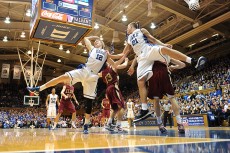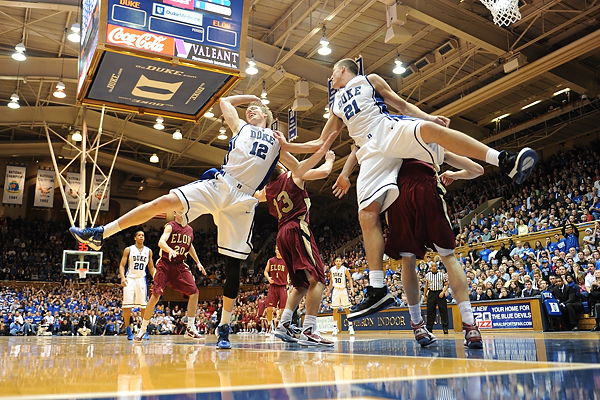Every season, narratives develop in college basketball, and at least one of them involves Duke. These narratives evolve a life of their own, the media clings to them, the fans shout them at each other. And, accurate or not, the narratives grow until they're larger than life.  In 2009-10, Duke rode the "alarmingly unathletic" narrative all the way to a title. But still today, you hear people refer to that team as unathletic.
In 2009-10, Duke rode the "alarmingly unathletic" narrative all the way to a title. But still today, you hear people refer to that team as unathletic.
This season, the narrative is that size matters: Duke is too small; the team has no "true center" and therefore can't defend big players; Amile Jefferson is too skinny; Jabari Parker plays like a small forward; teams with big front courts will eat Duke alive on the boards.
It's gotten louder this week, as Duke visits Chapel Hill, where the Tar Heels' "huge frontcourt" threatens to "pound" Duke on the boards.
But is any of it true? Is Duke to small to rebound effectively? Let's take a look and find out.
First of all, all numbers in this article will be minute-independent, tempo-free stats rather than counting stats. Because if you only look at how many rebounds a team gathers, you're not looking at the whole picture. For example, if a team plays at a fast tempo, there are more possessions and therefore more rebounding opportunities than if a team plays at a slow tempo. Similarly, if a team shoots for a high percentage, there would necessarily be fewer offensive rebounding opportunities than if a team couldn't hit the broad side of the proverbial barn. For an individual player, it's obviously hard to get a large quantity of rebounds if he doesn't play a large quantity of minutes. So, instead of "rebounds per game," we'll refer here to "rebounding percentage," meaning what percentage of available rebounds a team or player collects.
Second, this article will not actually refer to rebounds in general but will always distinguish between offensive and defensive rebounds. Why? Well, for starters, the two require different skills. Defensive rebounding is mostly about positioning and boxing out and bulk. Offensive rebounding relies more on quickness and hustle and slashing to the ball. Second, and this may sound obvious, but defensive rebounding is part of a team's defense and offensive rebounding is part of a team's offense. If a team shoots really well, there aren't so many misses and offensive rebounding becomes less important. If a defense forces lots of turnovers, there are fewer opposing shots to rebound. And so on.
It's not entirely clear, but it would seem that the narrative we've been discussing concerns defensive rebounding. Even if it didn't, for a Duke team that has been rated top five in the country on offense for the entire season (currently ranked #1 by the Pomeroy ratings) but has been rated defensively between the 60s and the 140s (currently ranked #93 by Pomeroy), defensive rebounding is clearly more important for Duke this season. So let's start there.
Well, before we start let's ask one more question: does it matter? If Duke rebounds poorly will that doom the team to a disappointing season?
When looking at team defensive rebounding percentages, the percentages generally range from the low 60s to the low 70s. A percentage of 64% would usually rank a team in the worst 100 teams in the country at defensive rebounding, while a percentage of 70% will in most years rank you in the top 100. Historically, Duke under Coach K has not been a good defensive rebounding team. In fact, twelve times in Coach K's 33 seasons at Duke, the team has had a defensive rebounding percentage worse than 64%:
1997: 59.5% (293rd in the country)
1990: 60.3%
1996: 60.7%
1994: 61.4%
1993: 61.5%
2000: 62.0% (278th in the country)
2006: 62.3% (309th)
1992: 62.8%
2004: 62.9% (291st)
2005: 63.3% (287th)
1991: 63.7
2001: 63.9 (249th)
More than half of Coach K's Final Four teams are on that list, including three of Duke's four national champions. So to the question of whether strong defensive rebounding is necessary for a successful season, the answer is a resounding no.
On the other hand, let's look at Coach K's Duke teams with the five best defensive rebounding percentages:
2007: 69.6% (55th in the country)
1989: 68.8%
2012: 68.1% (168th)
2013: 67.6% (194th)
2010: 67.5% (174th)
We have two final four teams, including one national champion, on that list so clearly defensive rebounding doesn't hurt, but it's interesting to see that two of Duke's best three seasons in this category, 2007 and 2012, are two of the most disappointing Duke seasons in Coach K's tenure.
Still, most would agree that you'd rather rebound well than poorly. So, how has this year's small Duke team with no true center been rebounding on the defensive end?
How about the best defensive rebounding team in all Coach K's time at Duke? You heard right. So far, the 2013-14 Duke team has rebounded 70.2% of available defensive rebounds, better than the team's previous record of 69.6%.
Not only has defensive rebounding not been a weakness for Duke this season, it has been one of the team's strengths. So much for that narrative.
But maybe you've heard a new narrative, that since Coach K changed his substitution pattern in the Virginia game, the team has been rebounding so much better. Maybe that explains it?
Not really. While it's true Duke's offensive rebounding has improved since the Virginia game (more on that later), Duke's defensive rebounding percentage has actually gone down in that period. Although still not bad, as we've rebounded 67.7% of available defensive rebounds in those games.
But how's all that possible, with "rail-thin" Amile Jefferson and "small forward" Jabari Parker manning Duke's frontcourt?
Because they're both really good rebounders. Parker currently leads the ACC in rebounds per game and is 5th in the conference in defensive rebounding percentage, at 22.9%. Jefferson's defensive rebounding percentage is even better -- 23.9% -- good for 2nd in the conference, trailing only UNC's Kennedy Meeks.
Going back to 1997, here's a list of Duke's ten best individual seasons for defensive rebounding percentage:
DEFENSIVE REBOUNDING PERCENTAGE (minimum 15 mpg)
1T. 2010 Brian Zoubek, 24.4%
1T. 2012 Mason Plumlee, 24.4%
3. 2014 Amile Jefferson, 23.9%
4. 2006 Shelden Williams, 23.4%
5T. 2013 Mason Plumlee, 23.3%
5T. 2011 Mason Plumlee, 23.3%
7. 2014 Jabari Parker, 22.9%
8. 2012 Miles Plumlee, 22.7%
9T. 2005 Shelden Williams, 22.0%
9T. 2004 Shelden Williams, 22.0%
Carlos Boozer's best defensive rebounding percentage was 19.6%. Elton Brand's best was 20.5%. Both squarely in Jefferson's and Parker's rear-view.
Jefferson's and Parker's combined percentage of 46.8% is the 2nd best Duke duo since at least 1997 (and probably a lot further back), just a smidgen behind Mason and Miles Plumlee combining for 47.1% in 2012.
Just imagine how successful Duke's current front line would be if they were big enough...
For completeness' sake, here's a brief tour of Duke's offensive rebounding. Historically, Duke's offensive rebounding is better than its defensive rebounding. On this end of the floor, 30% is generally bottom 100 and a little higher than 34% is top 100. In Coach K's time at Duke, the team has only been under 34% twice: last season (2013), at 28.8% (273rd in the country), and in 2006, at 30.9% (275th). Because, despite those low percentages, both those teams had top five (in the nation) offenses, one could fairly argue that it didn't matter whether they excelled in offensive rebounding or not.
On the other hand, here are the top 10 Duke offensive rebounding seasons under Coach K:
1999: 44.3% (3rd in the country)
1990: 40.9%
2010: 40.6% (6th)
1988: 40.5%
1998: 39.7% (39th)
1992: 39.5%
2004: 39.2% (16th)
1996: 38.3%
1991: 38.0%
1994: 38.0%
Wow, right? Eight of the ten teams on this list made the Final Four (including three of our four national champions). Only one team on the list didn't at least make the Elite Eight. So, maybe offensive rebounding is important, after all.
With that in mind, how's this year's team doing in this category? Well, that's where the new substitution pattern comes in. For the season, Duke's offensive rebounding percentage is 34.1%, good for 106th in the country. But since the Virginia game, we've corralled 42.3% of available offensive rebounds, which for a whole season would put us up at 1999/2010 levels.
Leading the charge on this side of the boards is, again, skinny Amile Jefferson. He's collected 15.2% of available offensive rebounds, which ranks 4th in the ACC (one spot ahead of UNC's Meeks) and 29th in the country. This number would rank fourth at Duke since 1997 (among players playing 15+ mpg):
OFFENSIVE REBOUNDING PERCENTAGE (minimum 15 mpg)
1. 2010 Brian Zoubek, 21.6%
2. 2012 Miles Plumlee, 16.6%
3. 1998 Elton Brand, 16.4%
4. 2014 Amile Jefferson, 15.2%
5. 2003 Shelden Williams, 14.8%
6T. 2004 Shelden Williams, 14.7%
6T. 2003 Casey Sanders, 14.7%
8. 1999 Elton Brand, 14.3%
9. 2002 Carlos Boozer, 13.5%
10. 2011 Miles Plumlee, 13.3%
If you drop the minute requirement down to 7 mpg, the following enter into the table:
2007 Brian Zoubek, 16.9%
2009 Brian Zoubek, 16.7%
2008 Brian Zoubek, 16.1%
2005 Reggie Love, 15.9%
2000 Matt Christensen, 15.1%
2014 Marshall Plumlee, 14.9%
So the emergence of Marshall Plumlee in the rotation since the Virginia game may have something to do with Duke's improved performance in this statistic. (MP3 has yet to show a proficiency for defensive rebounding, however.)
But the season isn't over yet. Duke's run on the boards will face a big test this week against North Carolina. The Tar Heels collect 38.4% of available offensive rebounds (17th in the country) and 69.0% of available defensive rebounds. The game will feature the ACC's top two rebounders in Duke's Amile Jefferson (2nd in DR%; 4th in OR%) and UNC's Kennedy Meeks (1st in DR%; 5th in OR%), who also happens to outweigh Jefferson by 80 pounds.
Will Duke continue its historic (and some would say unlikely) success on the boards? Tune in Wednesday to find out.

You must be logged in to post a comment.